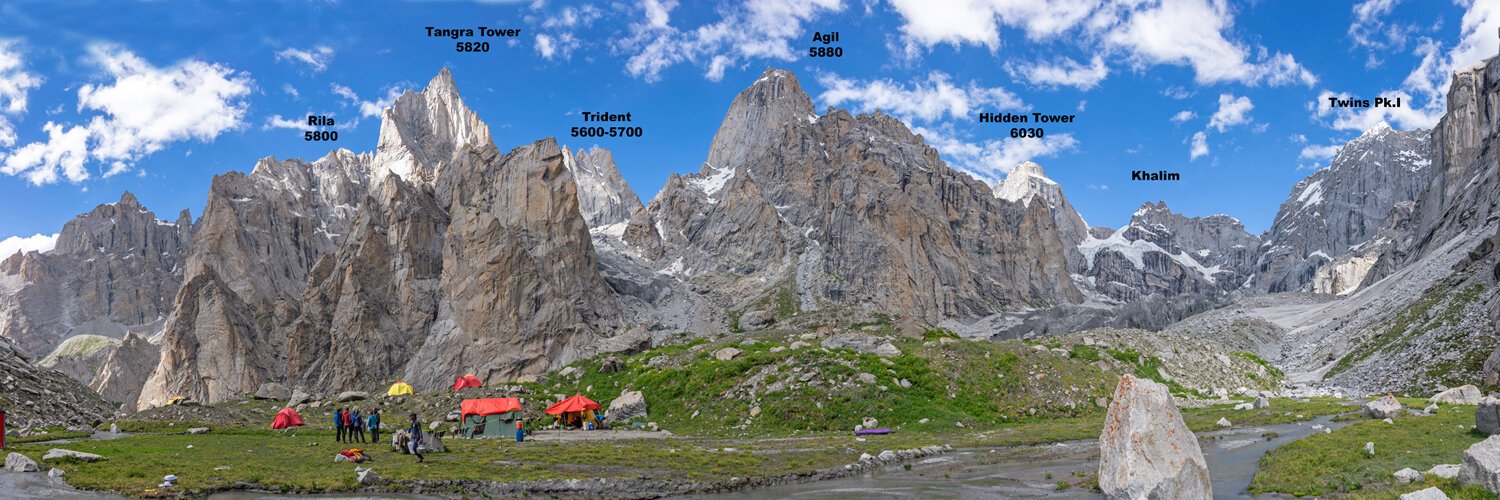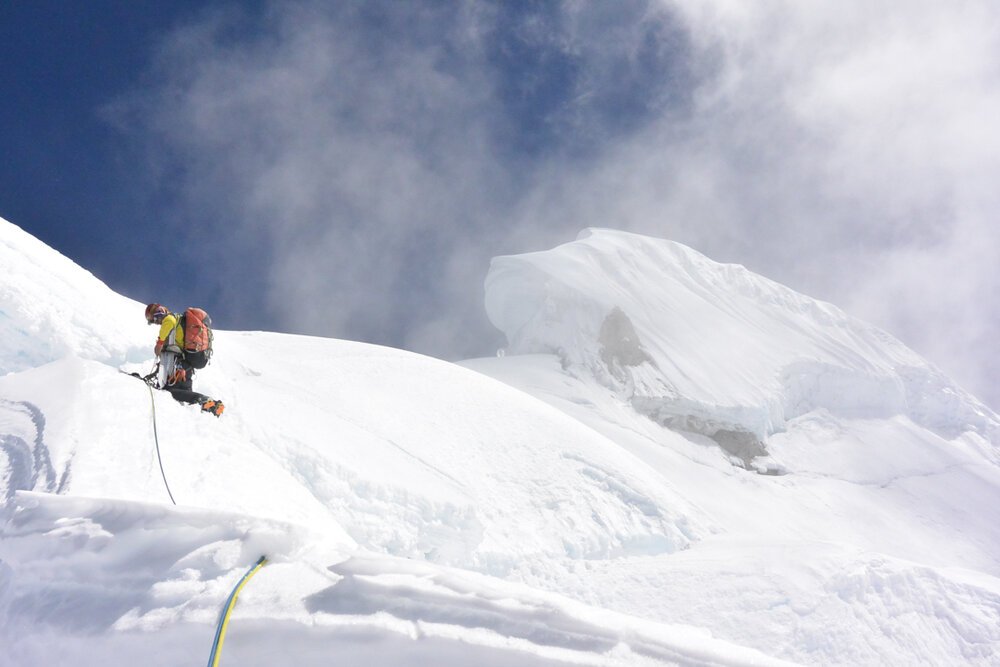An all-time base camp in the Khane Valley of Pakistan. Photo courtesy of Konstantin Markevich
A personal guide to less-visible highlights of the 2020 AAJ
By Dougald MacDonald, Editor
The American Alpine Journal is a 368-page book, and there’s probably only one person who reads it cover to cover: me. As editor in chief, I see and read everything multiple times, and each year a few parts of the book are particularly memorable—because of the quality of the writing or photography, because of the thrill of opening a folder of photos from little-known mountains, or because of the detective work that may go into a single sentence. But even if you did read every page, you wouldn’t see it all, because we can’t fit everything into the book—some of the coolest elements of the AAJ reside exclusively online.
Here, I offer an insider’s look at eight gems buried within the pages of the 2020 edition or hosted only at the AAJ website. In this guide, I’ve purposely skipped over the featured articles in the book. So, this is not a “best of” or an editor’s choice. Consider it a treasure map.
This special feature is made possible by Hilleberg the Tentmaker, lead sponsor of the AAJ’s Cutting Edge Podcast.
TANGRA TOWER, PAKISTAN
The Krasnoyarsk Route on the southeast face of Tangra Tower (5,820 meters). Photo by Konstantin Markevich
The AAJ’s 6-by-9-inch format does not handle panorama photos well, and the stunning photo at the very top of this page had to be cropped tightly for the book. At full width, it must be one of the most enticing photos for alpine rock climbers that we’ve ever published. The 2019 Russian expedition to the Khane Valley in the Karakoram climbed three peaks, including glorious Tangra Tower and the south summit of The Thumb (mislabeled as Trident in the photo above).
By the way, the first expedition to publish extensive photos of the Tagas Group, as this area is known, was a Bulgarian team in 2010. Their report and more photos were in AAJ 2011.
MT. BREITENBACH, IDAHO
One of the simple pleasures of my job is learning about unfamiliar mountains and ranges—even those within a few hundred miles of my home in Colorado. Marc Hanselman’s report about a new route up the north face of Mt. Breitenbach in Idaho’s Lost River Range, was one of these. I’d never even heard of Breitenbach, but for climbers who can nail the timing for good alpine conditions (this ascent was right after the summer solstice), the north face is an impressive target. Marc’s new route, climbed with Paddy McIlvoy, was possibly only the second line up this rugged face. All other known parties have climbed the original route, the Grand Chockstone Couloir, first done back in 1983. Talk about hidden gems!
Paddy McIlvoy on Cowboy Poetry (2,800’, IV 5.7 R AI2 50˚ snow) on the north face of Mt. Breitenbach (12,140’) in Idaho. Photo by Marc Hanselman
THE EIGER OF THE INYO, CALIFORNIA
Natalie Brechtel wondering what she got herself into as she completes the fifth pitch of the Northeast Buttress (1,300’, IV 5.9 R/X) of Pleasant Point. Photo by Richard Shore
AAJ colleagues know that I have an inordinate fondness for offbeat adventures (girdle traverses, kayak-and-climb extravaganzas, remote and arduous exploration, etc.). Climbing super-hard routes is impressive, but I also like to make space in the AAJ for creative climbing—even when the routes are highly unlikely to become classics. In AAJ 2020, a good example was Richard Shore’s exploration of “The Eiger of the Inyo,” the east face of Pleasant Point in the Inyo Mountains. Shore and Natalie Brechtel completed the first full route up the 1,000-foot wall of shattered limestone and dolomite. “[We] climbed what we deemed to be the ‘safest’ route on the far right side of the peak,” Shore wrote in his AAJ report. “Safe is a relative term on this cliff—torrents of climber-induced rockfall are inevitable, and the dolomite is so sharp that a fall by leader or follower seems likely to cut the rope. Steeper technical sections were interspersed with narrow alpine ridges, and most pitches took an hour or more to lead, due to navigational and protection difficulties in the choss. Soft-iron World War II Army surplus pitons proved to be most valuable—bolts were often worthless in the shattered mess, and hard steel pins would explode the rock into bits.” I can’t get enough of this stuff, and neither, apparently, can Richard Shore. He returned later the same year with Myles Moser for a harder, more direct line up the Inyo Mordwand.
JEBEL KHAZALI, JORDAN
Christian Ravier is a French guide who frequently works and climbs in Jordan (he also wrote the climbing guide to the Taghia Gorge in Morocco), and his report in AAJ 2020 brought us up to speed on some recent routes up the sandstone walls of Jebel Khazali in Wadi Rum. But it was his beautiful hand-crafted topos, complete with watercolor paintings (like this one of local guide and camp host Atayek Hamad), that really caught my eye. Christian’s unique topos weren’t suitable for our print edition, but three of these beautiful references can be seen with his report at the AAJ website. The rock looks pretty amazing, too!
LA GLORIA, MEXICO
We opened the Mexico section of AAJ 2020 with a scenic shot of La Gloria, a stunning mountaintop pyramid of limestone in the mountains west of El Salto in Nuevo León. As beautiful as Zach Clanton’s photo was, however, it didn’t convey the full allure of the climb: a 13-pitch 5.12 up the pillar splitting the south face. It’s an interesting lesson in the power of a route line drawn onto a photo—in this case, a photo that’s only available online. However you look at it, this is a fantastic piece of rock, which seems destined for popularity. Zach’s report at the AAJ website tells the full story of Rezando, the route he developed with Dave Henkel: “To me, the southern pillar of this peak was the Mexican Beckey-Chouinard, a line of perfect blue-orange limestone just begging to be the range’s first alpine sport climb.”
The south pillar of La Gloria (9,688 feet), showing the 1,500-foot route Rezando (13 pitches, 5.12). Photo by Zach Clanton
SIULÁ GRANDE, PERU
Luis Crispin leading out on the upper shoulder of the southeast ridge of rarely climbed Siulá Grande in Peru. Photo by Nate Heald
Nate Heald, a guide based in Cusco, Peru, has been a frequent contributor in recent years, climbing numerous new routes, mostly in the country’s southern ranges. In AAJ 2020, he reported on an ascent that was personally meaningful, in part because of the presence of his frequent partner Luis Crispin, who roped up with the teenage Thomas Schilter to become the first Peruvians to climb Siulá Grande in the Cordillera Huayhuash—and by a new route: Peruana Supreme (1,000m, TD AI4). In recent years, the AAJ has reported many new routes and first ascents of peaks by “local” climbers, throughout Latin America as well as in Pakistan, India, Nepal, and other mountainous countries. Many of these climbers work as guides but increasingly pursue their own ambitions in their local mountains.
Heald wrote in the Siulá Grande report: “I met Luis in 2011 on my way back to Cusco after a climb; he lives in a village at 4,300m below Ausangate and began assisting his uncle with tourist treks when he was 12 years old. He worked with me as I established my guiding agency, and since then we have done many climbs together. From my observations, Luis did not start climbing for any other reason than curiosity and camaraderie. He loves the natural world and has vast knowledge of it, and, at first, I think he just wanted to know what it would be like up there in the snow and ice. Luis and Thomas roped up together on Siulá Grande so no one could suggest they hadn’t made a purely Peruvian ascent of the peak.”
RAGGED RANGE, NORTHWEST TERRITORIES, CANADA
Amy Pagacz on top of a small peak in the Ragged Range after climbing Twisting Couloir (350m, AD). The high peak behind Pagacz is one of several mountains labeled Mt. Sidney Dobson on maps. This one is likely unclimbed. Photo by Wojtek Pagacz
Occasionally, AAJ editors get sucked down the rabbit hole of climbing archives. In AAJ 2020, we printed a short report about an interesting expedition to the Ragged Range in northwest Canada’s Logan Mountains—very few climbers have visited these mountains, which lie south of the popular Cirque of the Unclimbables, at the headwaters of the Fool’s River. The 2019 team climbed a few summits but couldn’t find a good approach to one of their biggest targets, which is labeled “Mt. Sidney Dobson” on many maps of the area. During the editing process, we realized that this Sidney Dobson had in fact been climbed way back in 1952 by an extraordinary expedition of Yale University students. The Yalies spent two and a half months in the area, built a log raft to cross a lake and access the mountains, and subsisted in part on game they shot and smoked, en route to summiting nine peaks, mostly first ascents. A great account of their trip is in the 1953 Canadian Alpine Journal.
Digging deeper, we realized that at least four different peaks in this cluster of mountains, all around 2,600m in elevation, have been called Sidney Dobson by various maps and publications. I spent hours attempting to determine which of the “Sidney Dobson” peaks might be the highest and whether it had been climbed, but the surveys are inadequate and the 2019 team couldn’t tell which was highest from their vantage points. Amy Pagacz’s expedition report and my attempt to unravel the Sidney Dobson mystery are both at the AAJ website. Unfortunately, the 2019 team found mostly poor rock on these impressive mountains and walls. But the first ascent of at least one Mt. Sidney Dobson may still be waiting.
MT. RORAIMA, GUYANA
Edward James lowers out on the Great Northern Prow of Mt. Roraima, watched by Troy Henry. The two men are from a nearby Akawaio community and had never worn a harness before the expedition. Photo by Matt “Pikey” Pycroft
Leo Houlding is a polished storyteller as well as a great climber, and his three-page story in AAJ 2020 about a new route on the northern prow of Mt. Roraima in Guyana is an excellent read. One of the highlights of this expedition was the role of Troy Edwards and Edward James, who live in the Akawaio village of Phillipai, the nearest settlement to the mountain. After guiding the British team to Roraima, the two accepted the Brits’ invitation to carry on up the wall, despite the fact that neither had ever climbed, jumared, or even worn a harness. In the end, they became the first people of Guyana to summit their country’s most famous mountain.
Sadly, we had to cut a full page and a photo from Leo’s story at the last minute, and three pages in the book didn’t come close to being enough for this tale. In fact, no article is as good as hearing Leo tell a story in person, so I highly recommend Chris Kalman’s interview with Leo for episode 27 of the AAJ’s Cutting Edge podcast. It’s great stuff.
The Cutting Edge and this AAJ year in review are both presented by Hilleberg the Tentmaker. Visit their website to learn more about their famous tents and order “The Tent Handbook,” Hilleberg’s uniquely informative catalog.










